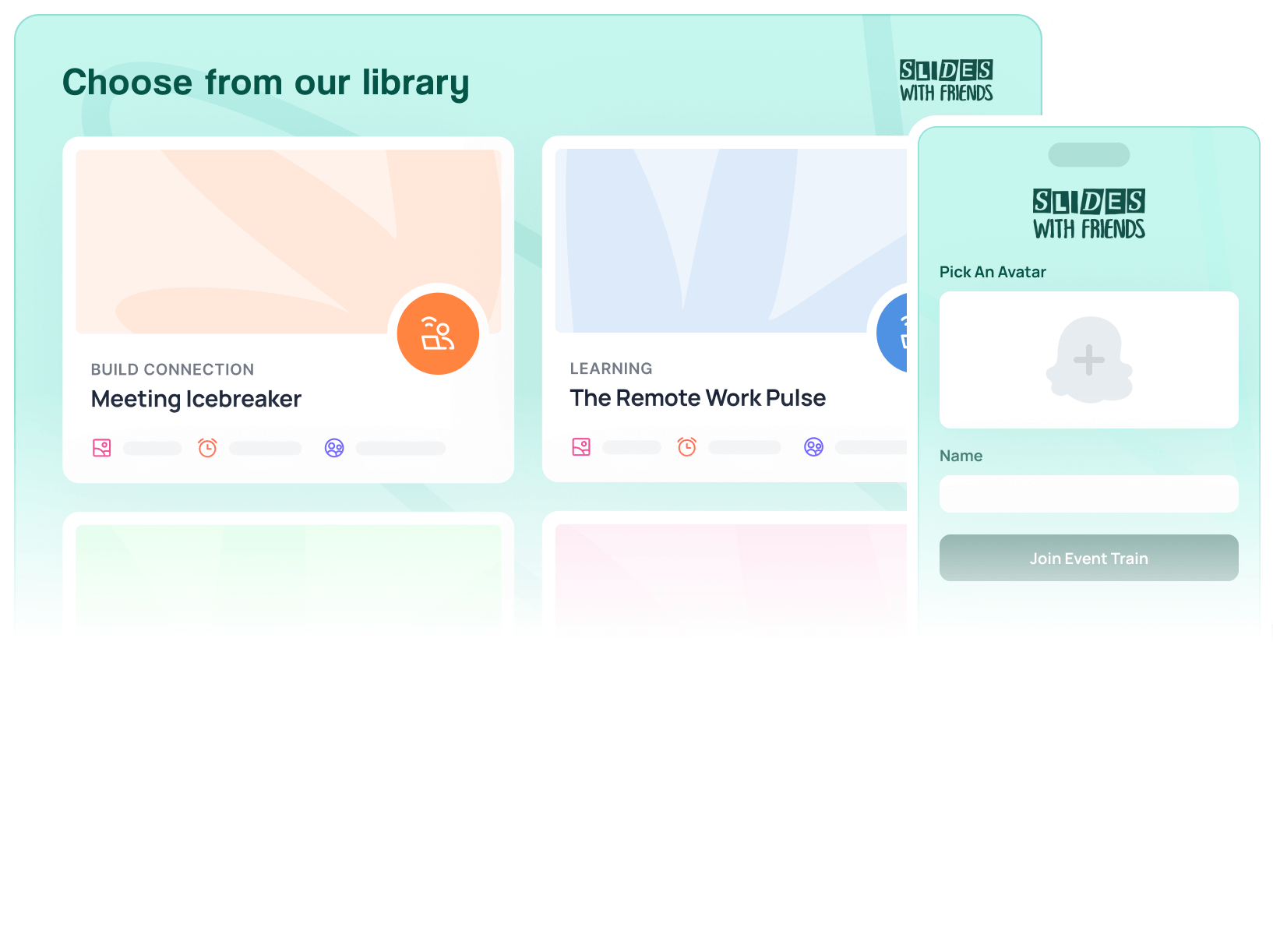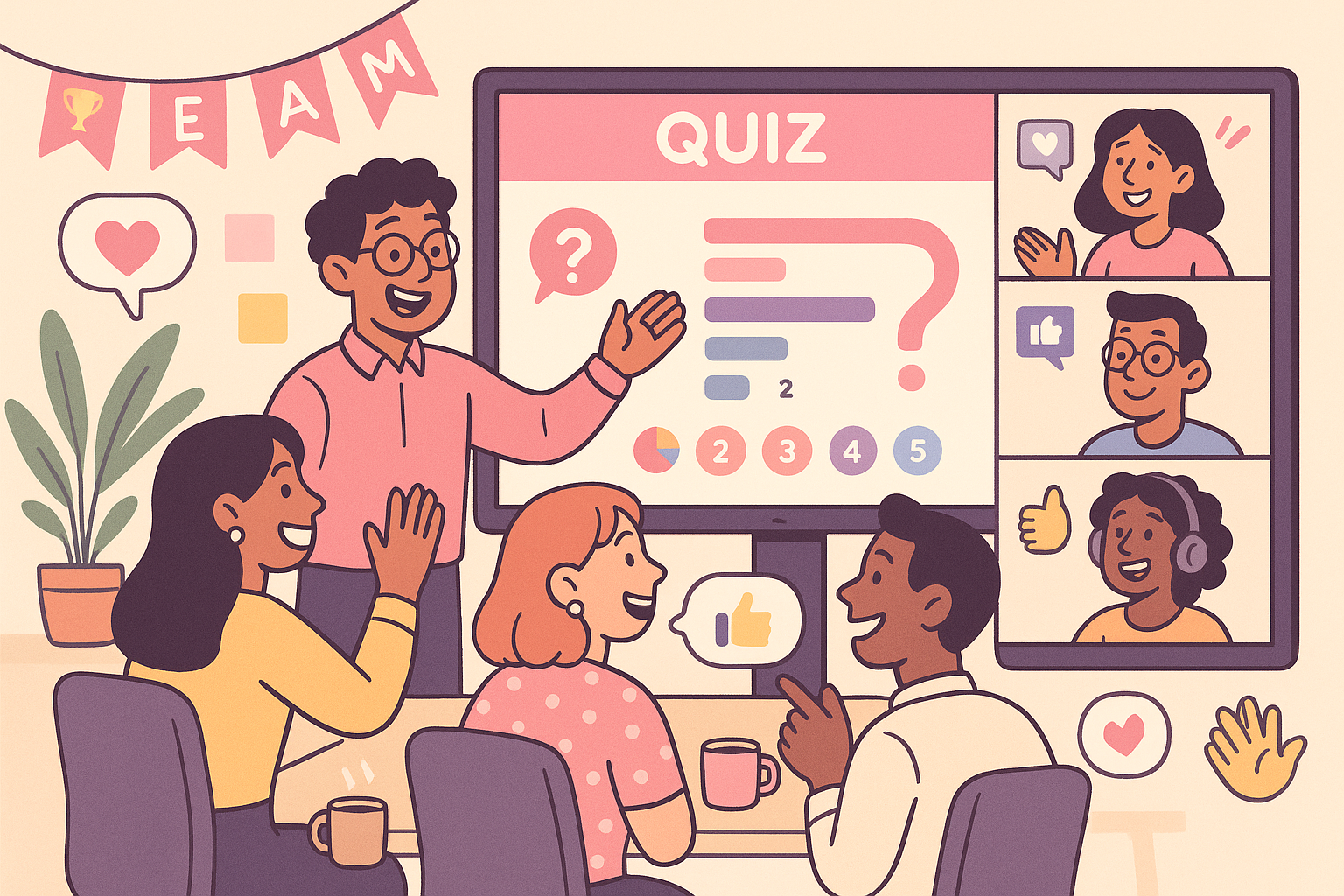How to Beat Zoom Fatigue
We're on video calls all the time — let's make them less exhausting. Here are actionable tools & tips to make Zoom calls less fatiguing for your remote team or audience.

The average remote manager spends over twenty hours every week in meetings. If you're on a remote or hybrid team, this means nearly half of your total time is spent on video calls. While these calls are a necessary way to connect with each other remotely, there's also a significant cost.

Free PDF Checklist
Download a pdf checklist with tips from this article that you can use each time you're hosting a meeting or event.
Download
Zoom Fatigue is a real problem
"Something about being on videoconference all day seems particularly exhausting, and the term 'Zoom Fatigue' caught on quickly," said Stanford researcher Jeremy N. Bailenson in his paper on "Nonverbal overload". There are several aspects of video calls that make them highly fatiguing, and these are the problems we'll be aiming to fix in this article:
- Increased mental effort and physical stress. Video calls add audio latency, break natural eye-contact habits, force us to remain seated in the center of a frame, and show us our own image to obsess over. All of this takes extra effort and leads to more fatigue than a physical meeting.
- Breakdown of group dynamics. Who's turn is it to speak? What did you say again? Wait, one at a time please. The group dynamics that are normally effortless and natural become impossible on Zoom without body language or physical proximity cues. This leads to a huge added effort, and added anxiety, involved in organizing a group.
- Loss of social cues and freedom Being able to hop to another browser window or look at your phone with impunity during a call may feel freeing — but it also means you can check out without ever actually indicating uninterest. You also can't (politely) get up and walk away. There's a complete break of the social cues and expectations: You can't telegraph your own, and you can't read those from others.

What causes Zoom fatigue
When a person talks about being tired from too many Zoom calls, there are usually two parts to their exhaustion:
- general meeting fatigue
- fatigue specifically from the video call medium
It's important to consider both of these when trying to optimize for the overall productivity and wellness of your team. No amount of fixing your Zoom calls will help if the underlying problem is too many meetings, meetings that are way too long, or meetings that were unnecessary or not relevant in the first place. Getting these basics in order is the first step to having a healthy remote meeting schedule.
Handling all of this requires you to have a high degree of control over your, your team's, or audience's schedule, and in many situations that's just not possible. In these cases, the best you can do is to try to make the video calls themselves less fatiguing.
🎮 Look at online games to find solutions
In stark contrast with Zoom, people often think of online games as relaxing and fun — even though these games also include social elements like calls and video, and even though many people spend hours and hours playing them.
Multiplayer games today were designed specifically for a remote, online environment, and these games have already found solutions to interacting and creating teamwork in this higher-latency, lower-bandwidth situation. They have already solved, or improved, many of the same issues that are being faced by all of us now in our never-ending stream of Zoom calls.

There are some key aspects of games that lead to a good remote experience:
- physical and mental freedom from good ergonomics
- structured social rules/interaction
- interactive by default
- surprise, relevance, and variety keep games interesting
Let's look at solutions:
1 — Optimize video call ergonomics
There's a set of ergonomics around the video call interface itself that can significantly reduce or increase your Zoom fatigue depending on the specific settings. We aren't talk about your desk chair, but are instead looking at things like enabling or disabling "self view" on Zoom, or sizing and positioning the video window to make for more natural eye-contact.
The Virtual Human Interaction Lab out of Stanford has identified three specific aspects of video calls that can lead to an increase in fatigue: self-view (watching yourself in real-time is fatiguing), unnatural eye-contact (too large or out of position), and a lack of physical mobility (tied to a chair/computer without any movement leeway whatsoever).
Fortunately, there are also solutions to each of these that can help quite a bit:
- Disable your "self view" (and ask your audience too). (Hover over your video and select "...", "Hide Self view") It can be intimidating to let go of your built in video mirror, but the relief you will feel is both instantaneous and fairly dramatic.
- Use wireless peripherals to add freedom of movement (e.g. a keyboard, mouse, microphone). Having physical freedom is natural and important in social situations, and not having it in video calls can cause significant stress and fatigue. Try a wireless keyboard, standing desk, or anything else that lets you move a bit more during a call.
- Correctly size and position your video windows. Make sure the size of face(s) isn't unnaturally large and position the window near your camera so that the eye contact is as close to natural as possible.
- Incorporate non-video interactions (audio-only, text, polls, reactions, etc). Adding non-video interactions to your meetings, be they live polls or an "audio-only" break, can reduce the amount of video time and provide some break to recoup energy.
- Vary screen-share and speaker views. Using other views like a full-size screen share can also provide a break from the fatiguing aspects of using direct video.
2 — Build a structure and communicate a set of rules
Zoom removes our ability to convey body language and the subtle nuances that create easy group dynamics. Video calls turn what would normally be many conversations with multiple lines of discourse into a single, linear flow that often has poor audio quality.
An unstructured Zoom call leads to people talking over one another, talking for longer than is appropriate, and sometimes leaves people out of the conversation entirely. It can feel like you are trapped in an anxious situation with no way out.

Providing a very clear structure for the call removes a lot of the above uncertainty and can help bring group calls back into a format that works well for everybody. Here's what we recommend:
- Know your goals up front and say them. Make sure your group has a clear takeaway or understands what you're trying to accomplish at the meeting.
- Create an agenda, distribute it, and stick to it. A clear agenda shows the group that you value their time, shows when people are expected to talk and for how long, and can keep the conversation on the agreed upon topic.
- Show your audience why this is relevant to them. Do you need their help to solve a problem? Are you a speaker addressing a commonly faced challenge? If your audience knows why this call is relevant they will be more engaged and less fatigued.
- Designate a moderator to keep the conversation on track. Normally we would walk away from somebody who is droning on for too long, but in video calls it's hard to do that. Make sure you have a moderator (can be you) that keeps people to designated time slots. Don't let people dominate the conversation.
- Bring quiet people into the conversation. Often there will be people who have strong opinions on the topic but are unable to express them over a louder person. This is a recipe for high stress and anxiety that you can easily alleviate by systematically giving all people a change to talk.
- Communicate your rules and expectations. Providing your group with clear rules will give them the confidence to participate freely and comfortably.
- Do you want video on or off? (ideally on)
- Audio muted or unmuted? (depends on audio quality and group size)
- Does your audience need materials in advance?
- Do you want to be interrupted with questions or hold until the end?
3 — Plan frequent interaction and feedback
Zoom removes much of the natural give-and-take that's present in a physical meeting. As a speaker it is near impossible to read your audience over a video call, and as a participant it's common to just feel "talked at" without having any personal agency or value whatsoever.

Both of these things can lead to quick boredom and fatigue for all parties, but thankfully this situation is easily remedied by adding scheduled interaction and feedback to your meeting. Adding interaction has the additional benefit of creating interest and excitement for the audience as they are now playing a real part in the meeting and will be much more engaged than if they were simply passive.
Here are some easy ways to plan for and incorporate group interactions into your call:
- Schedule several Q+A sessions. This can be done at several points during the meeting, but make sure it is well-structured and kept short and direct.
- Conduct a live poll or survey. Asking your audience for feedback in real time can really build engagement and a feeling of involvement for the whole group
- Encourage members to share something personal to them. There's nothing more exciting to a person than talking about themselves: adding in a section of personal sharing is a fast way to spice up a meeting and get group members involved.
- Get more than one speaker involved. Invite different team members to lead different parts of the call.
4 — Use surprise and variety to keep your group interested
Being interested or excited is (in many ways) the opposite of being fatigued. It's possible to combat many of the elements that lead to Zoom fatigue by ensuring your video call is a fun and engaging event for your audience. A group that is engaged and excited will behave very differently from an audience that is bored and tired.

Believe it or not, you don't need to be an extrovert to run an exiting event: there are some simple and predictable ways to add excitement to any event (many of which you see used by popular games).
- Use serendipity to keep your audience on their toes. One way to do this is to pose a question to the group and pick 3-5 members at random to answer the question. Another great way is to use breakout rooms.
- Add a joke or an animated GIF. No presentation will get worse because of an adorable puppy video.
- Don't use the same exact call structure every meeting. Adding even just a little bit of variety can keep people from getting bored and tired.
- Try using Slides With Friends (or a similar platform). Live polling and interaction tools like Slides With Friends can add a fun interactive component to your meeting. Participating in a two-way interaction is almost always more engaging than a one-way presentation.
- Try using different video call software or related tools. Tools like gather, Remo, and Tucan offer a "spatial video chat" option that can bring natural-esque movement and random groupings to a video event.
- Let your audience share & add content (and value). Call on your audience and let them bring content to your presentation. This will by nature be new and less predictable and can easily add some interest to a presentation.
Bottom line — Design your event experience intentionally
The bottom line to all of this is to carefully consider and plan your remote video calls. Build the experience around them in a way that helps reduce fatigue: deliberately engage your audience, make sure to carefully consider the ergonomics, and bring some interactive elements into the mix.

Free PDF Checklist
Download a pdf checklist with tips from this article that you can use each time you're hosting a meeting or event.
Download
Using these tools and tips you should be able to run meetings that are not only not-exhausting, but are also exciting and valuable to all of the participants.
Try these out and let me know if you have tips or comments. You can send an email to hi [at] slideswith.com or follow me on twitter for more content like this.


Ready to ditch the dull, and run team sessions that people will actually enjoy?
Get started with a Slides with Friends deck in no time. We’ve got all the interactive features you need in one easy-to-learn, easy-to-set-up tool.















